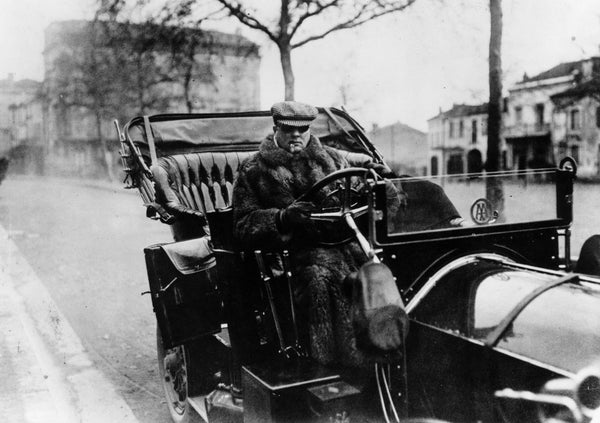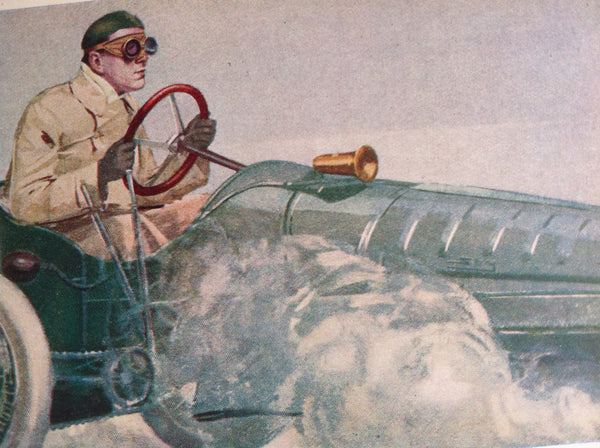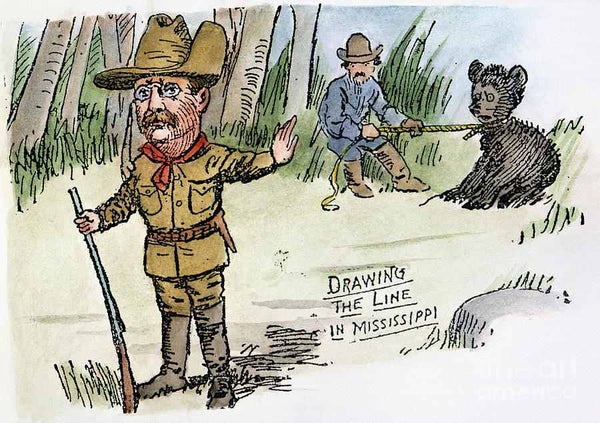THE TEDDY BEAR COAT
British brand Motoluxe was established at the dawn of the automobile age, designing and making products to keep winter motorists warm, dry and comfortable.

Lord Northcliffe at the wheel of his 135 hp Mercedes (1908)
In the early 1900s, motoring was a privileged activity and considered to be an outdoor sport. Most cars were open-topped, leaving the drivers and passengers exposed as they sped along tracks designed for horse-pulled carriages. It was therefore a necessity to wear protective clothing.

Early motorists faced challenging conditions
In addition to the essential hat, gloves and goggles, summer driving called for a long double-breasted dust coat (also known as a “duster”) usually made from durable cotton or linen. During the colder months, the materials changed to heavy tweeds, leather and fur… and in the case of Motoluxe, it was deep-pile Alpaca fur fabric.

Early C20th British motoring apparel advertisement
Natural fur was the more popular choice in the United States, given that many parts of the country experienced much harsher weather conditions than Britain, and also due to the abundant supply of pelts from the native raccoon.

Raccoon automobile coat advertisement (1906)
The winter driving combination of fur coat, leather gauntlets, cap and goggles made quite a statement. It spoke of status, glamour, adventure and excitement. The look was beautifully portrayed in J.C.Leyendecker’s masterful illustration for the cover of Collier’s magazine in January 1918.

Colliers magazine cover illustration by J.C.Leyendecker (1918)
By the 1920s, the raccoon coat was more than a piece of protective clothing – it had become an essential fashion item amongst Ivy League university students. The driving cap was replaced with bowlers, trilbies and straw boaters, and the coats were worn to ballgames rather than on the road.

U.S. college students in raccoon coats (c1920s)
The extravagance of the look in some ways mirrored the movement at Oxford University at the time, where male students began wearing excessively wide trousers that became known as Oxford Bags. It was a sign of fraternity amongst the intellectual elite, and the raccoon coat craze inspired jazz band leader George Olsen to release a recording in 1928 entitled, “Doin the Raccoon”, with the following lyrics:
From every college campus comes the cheer: oy-yoy!
The season for the raccoon coat is here, my boy!
Rough guys, tough guys, men of dignity,
Join the raccoon coat fraternity, soon,
To do the raccoon!
The year after Olsen's recording hit the air, the November 16, 1929 issue of The Saturday Evening Post featured an Alan Foster illustration of several college men wearing raccoon coats. The image symbolised the Jazz Age, but the party was about to end. Wall Street had crashed the previous month, triggering the Great Depression, and shows of ostentation would no longer fit with the mood of the nation.

The Saturday Evening Post cover illustration (1929)
Whilst US fur trappers had been kept busy during the first quarter of the 20th century, the Yorkshire mills of England were supplying woollens to the world’s clothiers. During the 1830s, the county had been responsible for the first commercial production of Alpaca fabric, and the soft, lustrous, yet resilient fibre was now being used to produce deep-pile fur fabrics.
Motoluxe utilised the warm, lightweight material to produce coats and travel rugs designed for use “on land, on sea, and in the air”, and branded them with a distinctive triangular label.

Early C20th Motoluxe advertisement
In Germany, a business named Schulte began manufacturing the woven fur fabric in 1901, and within 12 months, fellow German company Steiff used the material to produce the world’s first stuffed toy bear. During the same year, a peculiar event in the US led to the eventual christening of the popular children’s toy.
In November 1902, United States President Theodore Roosevelt (who was commonly known as Teddy) joined a bear hunt along the Mississippi River. Towards the end of the day, several hunters had made a kill, but the President hadn’t been lucky. Following a long and exhaustive chase, a group of Roosevelt’s attendants captured an American black bear and tied it to a willow tree. They called upon the President to shoot the bear, but he refused, deeming it to be unsportsmanlike.

The Washington Post cartoon illustrated by Clifford Berryman (1902)
The incident became the topic of a political cartoon by Clifford Berryman in The Washington Post on November 16, 1902, and the story spread like wildfire throughout the US. Inspired by the episode, a Brooklyn candy-store owner produced a toy bear and was granted use of the President’s name to promote the product - which he placed in his shop window along with a sign reading, “Teddy’s Bear”.
Meanwhile, back in England, the woven alpaca fur fabric continued to keep motorists warm and comfortable well into the 1920s (efficient heating didn’t appear in cars until the following decade). At some point in history, given that they were made out of the same material, the fluffy double-breasted car-coats became known as Teddy Bear Coats.

Punch magazine illustration of a teddy-bear coated motorist (1905)
To illustrate how the garments had progressed from protective clothing in the early 1900s to elegant outerwear in the 1920s, a gloriously impractical cream-coloured version of the coat was made for Jeremy Iron’s role as Charles Ryder in the celebrated television adaptation of Evelyn Waugh’s novel “Brideshead Revisited” that was set in the period.

Jeremy Irons as Charles Ryder in Brideshead Revisited
During the more austere times of the 1930s, teddy bear coats continued to be worn. The cabin conditions of aircraft and automobiles had started to become more comfortable, but if you had chosen to travel by sea, alpaca fur fabric would be perfect to wear on deck – as can be seen in the photograph of Salvador Dali standing aboard the S.S.Normandie as it docks in New York City, on December 7th, 1936.

Salvador Dali keeping warm on the deck of S.S.Normandie (1936)
Understandably, the War years provided little demand for the coats and it wasn’t until the 1950s that a renewed interest materialised (clothing rationing had continued until 1949). Famously, in 1954, Sir Winston Churchill took delivery of the Land Rover that had been custom built for his 80th birthday, in which he was chauffeured around his Chartwell estate wearing an Alpaca teddy bear coat.

Churchill, Land Rover and Teddy Bear coat: three icons in one image
The fortunes of Motoluxe were revived during this period, as faux-fur coats became a popular fashion for ladies, and the company focussed its attention on garments for the fairer sex, which they sold from their Conduit Street showroom in Mayfair. They played down their menswear products (which may not have been the perfect partner for the demob suits still in circulation) and suggested that, whilst luxurious, the coats were "quality without extravagance".

Motoluxe coat advertisement (1950s)
In the 1960s, styles and attitudes were about to experience another dramatic change as the Peacock Revolution took hold in England, and a new spirit of dandyism began to pervade the lives of young men. Amongst those leading the charge was Rolling Stones front man Mick Jagger (seen photographed below in 1966 wearing a brown teddy bear coat). The sartorial excess of fur and lace, followed by satin and glitter in the subsequent Glam Rock era, survived until the mid-1970s when the mood of the nation swung again.

Mick Jagger photographed on the rooftop of his Marylebone home (1966)
The outbreak of the 1973 oil crisis and stock market crash proved yet again that a bear-market was not a suitable climate for teddy-bear coats. The economic hangover led to the sobering up of dress codes. Britain had fallen into industrial decline, and the Motoluxe brand disappeared – along with the Yorkshire mills that had been supplying the company with Alpaca fabric.
German fur-fabric manufacturer Schulte managed to survive into the 21st century, continuing to provide Steiff with goods for the production of heirloom teddy bears (some of which have sold for tens of thousands of pounds at auction). In 2009, when Schulte’s future looked uncertain, Steiff acquired the company to secure supply of its essential material.

A rare Steiff black "Titanic" teddy bear made in 1912 sold for £91,750 at auction
Vintage toy bears are not the only fur-fabric products to have stimulated bidding wars. In October 2012, a teddy bear coat made in 1934 for menswear retailer Austin Reed managed to fetch £20,400 at auction. Whilst the winning bidder was described as having “deep pockets”, the sale was a measure of the interest in such iconic pieces of British tailoring history.

The 1934 Teddy Bear Coat sold to a man with deep pockets
In 2016, following more than 40 years in hibernation, it was considered time to reawaken the beast, and the Motoluxe brand was brought back to life. Naturally, Schulte were called upon to provide the materials from which a new breed of teddy-bear coats would be born. This, together with an extended family of unstructured Alpaca sports coats, has laid the foundations for a modern collection of performance tailoring that is perfect for a contemporary lifestyle, and, of course, for travel - on road, on sea, and by air.
The Motoluxe Alpaca Teddy Bear Coat in Brown

